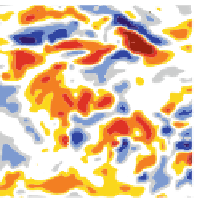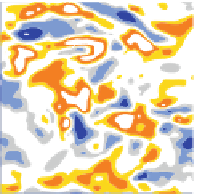Geoscience Reference
In-Depth Information
a
b
c
FD: 20010315 12UTC t+12
L
44
u
-wind
TL_nonreg: 20010315 12UTC t+12
L
44 u-wind
TL_reg: 20010315 12UTC t+12
L
44
u-wind
5
12
12 10
12
5
8
8 10
8
5
4
4 10
4
5
2
2 10
2
5
1
1 10
1
5
0.5
0.5 10
0.5
5
-
0.5
-
0.5
-
0.5 10
5
-
1
-
1 10
-
1
5
-
2
-
2 10
-
2
5
-4
-4 10
-
4
5
-
8
-
8 10
-
8
5
-
12
-
12 10
-
12
Fig. 11.2
Zonal wind increments around 700 hPa after 12-h evolution: (
a
) finite-differences
(FD), (
b
) tangent-linear (TL) model without any regularization and (
c
) TL model with applied
regularization in the cloud parametrization scheme
derivatives of model outputs with respect to the model state variables become very
large, the linearization will become useless.
As an illustration of how strong nonlinearities can lead to erroneous behaviour of
the tangent linear model, Fig.
11.2
b shows the evolution of zonal wind increments at
the model level around 700 hPa when using the TL model without any regularization
in the cloud parametrization scheme. When compared to the finite differences
(differences between two non-linear integrations) in Fig.
11.2
a, one can notice that
strong spurious noise develops in the tangent linear model. This noise comes from
the autoconversion function (Fig.
11.1
) describing the conversion of cloud water
to precipitation. When regularization is applied to this function, TL increments
(Fig.
11.2
c) agree well with the finite differences (Fig.
11.2
a).
11.6
Performance of the Linearized Physics
11.6.1
TL Approximation
Once discontinuities in the different physical parametrization schemes have been
properly smoothed, the TL model describing the evolution of perturbations with the
simplified physical parameterizations generally fits the finite differences between
two non-linear forecasts much better than an adiabatic TL model.
To demonstrate the impact of the different physical processes in the TL model,
experiments have been performed at a horizontal resolution equal to T255 and
91 levels in vertical (L91) using the linearized physics of ECMWF described in
Sect.
11.5
. The impact of the different physical processes on the tangent-linear
evolution of temperature and zonal wind increments is shown in Fig.
11.3
. Results
are presented in terms of zonal mean of error difference as in (
11.7
) (i.e. the fit
to the non-linear model with full physics) between the TL model including the
whole set of linearized parametrization schemes and the adiabatic TL model (i.e.












































































































































































































































































































































































































































































































































































































Search WWH ::

Custom Search